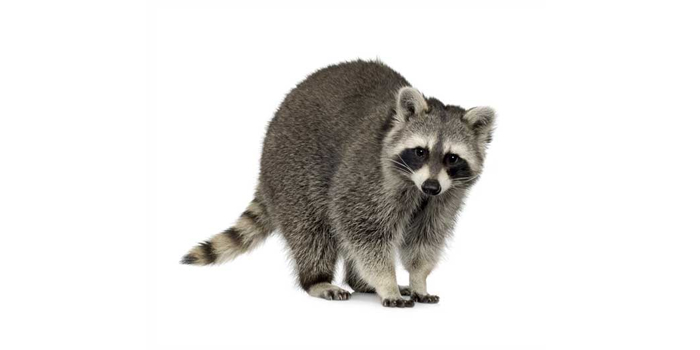
We’re the leading providers of pest control exterminator services for Wildlife Raccoons in Union NJ
Please give us a call at 908 982 4718 in order to get started with the process.
Raccoon
The raccoon, sometimes spelled racoon,[3] also known as the common raccoon,[4] North American raccoon,[5] northern raccoon,[6] or coon, is a medium-sized mammal native to North America. The raccoon is the largest of the procyonid family, having a body length of 40 to 70 cm (16 to 28 in) and a body weight of 5 to 26 kg (11 to 57 lb).[7] Its grayish coat mostly consists of dense underfur which insulates it against cold weather. Three of the raccoon’s most distinctive features are its extremely dexterous front paws, its facial mask, and its ringed tail, which are themes in the mythologies of the indigenous peoples of the Americas. Raccoons are noted for their intelligence, with studies showing that they are able to remember the solution to tasks for at least three years.[8] They are usually nocturnal and omnivorous, eating about 40% invertebrates, 33% plants, and 27% vertebrates.
The original habitats of the raccoon are deciduous and mixed forests, but due to their adaptability they have extended their range to mountainous areas, coastal marshes, and urban areas, where some homeowners consider them to be pests. As a result of escapes and deliberate introductions in the mid-20th century, raccoons are now also distributed across much of mainland Europe, Caucasus, and Japan.
Though previously thought to be generally solitary, there is now evidence that raccoons engage in sex-specific social behavior. Related females often share a common area, while unrelated males live together in groups of up to four animals to maintain their positions against foreign males during the mating season, and other potential invaders. Home range sizes vary anywhere from 3 hectares (7.4 acres) for females in cities to 5,000 hectares (12,000 acres) for males in prairies. After a gestation period of about 65 days, two to five young, known as “kits”, are born in spring. The kits are subsequently raised by their mother until dispersal in late fall. Although captive raccoons have been known to live over 20 years, their life expectancy in the wild is only 1.8 to 3.1 years. In many areas, hunting and vehicular injury are the two most common causes of death.
Wildlife
Wildlife traditionally refers to undomesticated animal species, but has come to include all organisms that grow or live wild in an area without being introduced by humans.[1] Wildlife can be found in all ecosystems. Deserts, forests, rainforests, plains, grasslands, and other areas, including the most developed urban areas, all have distinct forms of wildlife. While the term in popular culture usually refers to animals that are untouched by human factors, most scientists agree that much wildlife is affected by human activities.[2]
Humans have historically tended to separate civilization from wildlife in a number of ways, including the legal, social, and moral senses. Some animals, however, have adapted to suburban environments. This includes such animals as domesticated cats, dogs, mice, and gerbils. Some religions declare certain animals to be sacred, and in modern times, concern for the natural environment has provoked activists to protest against the exploitation of wildlife for human benefit or entertainment.
The global wildlife population decreased by 52% between 1970 and 2014, according to a World Wildlife Fund report.
Stone Age people and hunter-gatherers relied on wildlife, both plants and animals, for their food. In fact, some species may have been hunted to extinction by early human hunters. Today, hunting, fishing, and gathering wildlife is still a significant food source in some parts of the world. In other areas, hunting and non-commercial fishing are mainly seen as a sport or recreation. Meat sourced from wildlife that is not traditionally regarded as game is known as bush meat. The increasing demand for wildlife as a source of traditional food in East Asia is decimating populations of sharks, primates, pangolins and other animals, which they believe have aphrodisiac properties.
In November 2008, almost 900 plucked and “oven-ready” owls and other protected wildlife species were confiscated by the Department of Wildlife and National Parks in Malaysia, according to TRAFFIC. The animals were believed to be bound for China, to be sold in wild meat restaurants. Most are listed in CITES (the Convention on International Trade in Endangered Species of Wild Fauna and Flora) which prohibits or restricts such trade.
Squirrels
Squirrels are members of the family Sciuridae, a family that includes small or medium-size rodents. The squirrel family includes tree squirrels, ground squirrels, chipmunks, marmots (including groundhogs), flying squirrels, and prairie dogs amongst other rodents. Squirrels are indigenous to the Americas, Eurasia, and Africa, and were introduced by humans to Australia.[1] The earliest known fossilized squirrels date from the Eocene period and are most closely related to the mountain beaver and to the dormouse among other living rodent families.
The word “squirrel”, first attested in 1327, comes from the Anglo-Norman esquirel which is from the Old French escurel, the reflex of a Latin word sciurus. This Latin word was borrowed from the Ancient Greek word skiouros, which means shadow-tailed, referring to the bushy appendage possessed by many of its members.[2][3]
